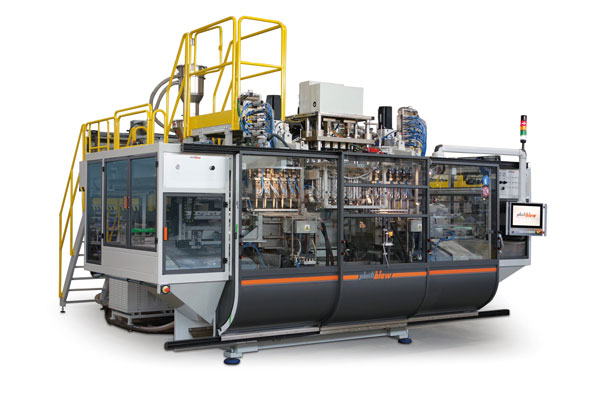 Plastiblow boasts extensive experience and meets customers’ requirements thanks to a comprehensive machine range and custom solutions
Plastiblow boasts extensive experience and meets customers’ requirements thanks to a comprehensive machine range and custom solutions
In the ever-evolving landscape of the food industry, advancements in technology play a crucial role in enhancing efficiency and quality. Among the various manufacturing processes, extrusion blow moulding machines has emerged as key player, especially in the production of bottles for popular condiments like ketchup and mayonnaise, as well as in the dairy sector for yogurt containers.
Ketchup and mayonnaise bottles
The use of extrusion blow moulding machines has revolutionized the production of ketchup and mayonnaise bottles. These machines allow for the creation of bottles with precise shapes, sizes, and thicknesses. The lightweight nature of the bottles reduces transportation costs and environmental impact. Additionally, the versatility of extrusion blow moulding enables the incorporation of innovative designs and features, such as easy-to-squeeze shapes and portion control dispensers, catering to consumer preferences and convenience.
Moreover, coextrusion technology allows for the creation of bottles with distinct layers, each serving a specific purpose. For example, an inner layer with barrier properties prevents the permeation of oxygen, preserving the quality of the condiments. Meanwhile, an outer layer provides structural integrity and can be customized for branding and aesthetic appeal.
Plastiblow has an extensive experience in supplying a diverse range of machines within this industry. Among the most interesting Plastiblow models offered for this production:
• PB22ED-1200 with eight head Coex 6 Layer, for production of ketchup and sauce bottles in 8+8 cavities at 125mm CD
• PB6ED with Quad head Coex 6 Layer, for production of flavoured milk bottles in 4+4 cavities
In the dairy sector, extrusion blow moulding machines are instrumental in the production of containers for drinkable yogurt. The ability to create custom shapes and sizes ensures that these containers meet the specific requirements of dairy products. The machines facilitate the production of lightweight and tamper-evident containers, maintaining the freshness and quality of the yogurt. Moreover, the production process allows for the inclusion of ergonomic features, such as easy-grip surfaces and resealable lids, enhancing the consumer experience.
Depending on the size and format of the bottles, Plastiblow machines feature usually up to 24 cavities for oriented production, or up to 40 cavities with the bottom-to-bottom or neck-to-neck arrangements, according to the production requirement.
Among the most interesting models offered for high productivity we can consider those defined as “long stroke” models. This expression describes extrusion blow moulding machines that can host moulds with a high number of cavities with outputs that achieve several million pieces per year, once obtained only with rotary machines.
In most cases yogurt bottles have wide neck finishing with an annular surface for the thermo-welding of a protective peelable foil. For the best finish on these necks Plastiblow designed a specific wide mouth cutter, that allows the complete finishing of the bottle in the machine, with important advantages for the layout and space saving in the plant. Plastiblow full electric machines proved to be ideal for the production of yogurt bottles in clean rooms or controlled atmospheres, mainly because of the complete absence of hydraulic oil that avoids any risk of contamination of both products and the environment.
 For example, for the production of yogurt bottles up to 500 ml, Plastiblow has just successfully tested and delivered two turnkey systems mod. PB15ED-800 ml with 8+8 cavities, dome cutting system and leak tester.
For example, for the production of yogurt bottles up to 500 ml, Plastiblow has just successfully tested and delivered two turnkey systems mod. PB15ED-800 ml with 8+8 cavities, dome cutting system and leak tester.
Other applications for the drink packaging industry, such as flavoured milks or vitaminized beverages, require barrier containers with multilayer configurations or special sealed-neck bottles to protect the bottle interior from contaminations. Working side by side with several customers, Plastiblow has also gained good experience in supplying many coextrusion machines with different multilayer configurations, thus being able to support customers also for this kind of applications.
A 3-layer configuration is used on milk bottles, with a black coloured layer in the middle, for light barrier on:
• UHT bottles for long shelf life
• Fresh milk bottles, to block out refrigerator light on store shelves, to maintain the taste unaltered and keep nutrient content from degrading.
Advantages of extrusion blow moulding in food packaging:
1. Cost efficiency: Extrusion blow moulding processes is cost-effective, allowing manufacturers to produce large quantities of standardized containers at a relatively low cost per unit.
2. Design flexibility: This process offers unparalleled design flexibility, enabling the creation of intricate shapes and customized packaging solutions that meet the unique requirements of different food products.
3. Lightweight and durable: The resulting containers are lightweight yet durable, reducing material usage and transportation costs while maintaining the integrity of the packaged food items.
4. Environmental sustainability: The lightweight nature of the containers contributes to environmental sustainability by reducing carbon emissions during transportation and promoting the use of recyclable materials.
5. Efficient production: Extrusion blow moulding machines operate efficiently, ensuring high-speed production and quick turnaround times, essential factors for meeting market demands.
The integration of extrusion/coextrusion blow moulding machines in the food industry has transformed the way food products are packaged. From ketchup and mayonnaise bottles to drinkable yogurt containers, these machines offer cost-effective, flexible, and environmentally friendly solutions. As consumer preferences and industry standards evolve, the utilization of extrusion blow moulding technologies will likely continue to play a pivotal role in shaping the future of food packaging. Manufacturers embracing these innovations are poised to enhance their production processes, meet consumer demands, and contribute to a more sustainable and efficient food industry.



